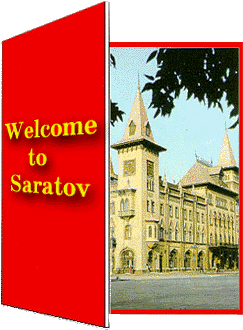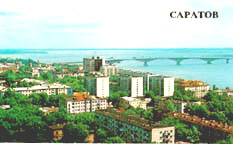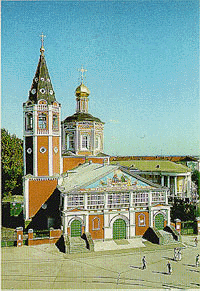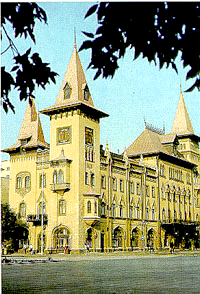


Natural conditions in Saratov province are not uniform: the north and northwest, on the right bank, is a forest-steppe, the rest of the right-bank region and almost all left-bank region, except for the extreme south, are steppes, and the southeast of the province is a semidesert. Saratov's climate is continental.
Saratov was founded in 1590. The name of the city comes from the Tatar word Sary-Tau (Yellow mountain). During its 400 year history Saratov has served as the crossroads for many historical events and outstanding people. In the late 19th century Saratov became a regional center for industry, trade, and culture. By that time, Saratov had become famous for its agricultural products, fishing and salt industries, as well as for manufacturing and metal processing.
The city's architecture has been influenced by both European and Asian cultures. The downtown has a large number of buildings built at the turn of the centuries in provincial modern, pseudo-gothic and Moscow baroque style. The university campus, the Covered market, the conservatory, Trinity (Troitsky) and The Spirit Coming Down (Dukhososhestvensky) cathedrals are some of the best examples of these styles. Among the modern landmarks of Saratov is the 2.8 kilometer bridge which connects Saratov with Engels.
Saratov's climate is much like the climate of Chicago. The average winter temperature is 11 degrees Fahrenheit and the average summer temperature is 70 degrees Fahrenheit.
Saratov was famed for the longest straight street in Europe, Moskovskaya (Moscow) street. Among the landmarks of modern Saratov is one of the longest bridges in Europe, 2.8 kilometers long.

Saratov offers many of the advantages of a larger city, but has the moderate prices of a smaller city. It has: a drama theaters, a children's theater, a puppet theater, Russia's oldest active circus, an opera, ballet, philharmonic orchestra, musical conservatory, and professional basketball, hockey and soccer teams. There are also has several beaches, Lipki Park, several Art Galleries, many fine cafes and restaurants, a good disco, supermarkets with foreign foodstuffs, two casinos and several delicatessens.

Saratov is the educational center of Central Russia, with 9 institutions of higher education and 21 of research & science. Saratov's scientific societies, amoung the oldest in Russia, laid the foundation for the city's academic life. Saratov University is one of the oldest and best respected universities in Russia. Currently there are four institutes affiliated with the Russian Academy of science conducting research in Saratov: Most of Saratov's institutions offer classes in accounting, economics, computers and other needed business skills. Saratov offers a highly skilled and well educated labor base. It also has facilities for worker retraining.

The Saratov Airport is located in the city proper and is very accessible. It can be reached in less than 15 minutes from downtown It offers air service though out Russia, including Siberia and some of the former republics. It has service to most of Russia's major cities with frequent flights to Moscow and St. Petersburg. An Aeroflot office is located in the downtown region as well as at the Airport.

Saratov is an important railway junction, connecting the center of Russia with the Urals, Siberia and Soviet Central Asia. Since 1993 Saratov has the ΠΕΤ railway direction "Saratov-Berlin". Every day 200,000 tons of goods and 30,000 passengers arrive in Saratov and leave it. The Board of the Privolzhskaya railroad, one of the oldest in Russia (built in 1870), is in Saratov. Saratov's airport connects the city with Moscow, Volgograd, Saint Petersburg, Samara, the health resorts of the Caucasus and the Crimea, as well as with numerous of the province's administrative districts.Saratov has a well developed rail system, for both the freight and passengers. There are 3 trains daily to Moscow, along with service to Berlin and Warsaw. All of Russia's larger cities can be reached via the rail system. Every day more than 200,000 tons of consumer and industrial goods, along with 30,000 passengers use Saratov's rail system.
Saratov is an important Volga riverport. Water routes connect the city with the industrial center of Russia, Moscow (the Moscow canal), the western Urals (the Kama river), the Black sea (the Volgo-Don canal), and the Baltic and White seas (theVolgo-Balt waterway). In summer, fifty ships per hour arrive at Saratov ports. A mechanized cargo port has been constructed in the southern part of the city. Saratov is at the crossroads of a number of highways, connecting the city with Voronezh, Penza, Volgograd, Samara, Tambov, and other Russian cities. The Volga River connects Saratov with most of Russia's main the Western Urals, the Black , Baltic and White Seas. The Vogue River is normally negotiable from late April to early October. The cargo port was recently expanded and fully renovated to accommodate heavy industrial use.
The city's public transportation system includes a trolley line and bus system. The roads are better maintained than is normal in Russia. All of the cities in the Volga region can easily be reached via the national highway system.
The Saratov-Moscow gas pipeline, 843 km long, passes through Saratov. The Saratov pipe junction serves the pipelines Stepnoye-Saratov (which crosses the Volga), Zhirnoye-Kologrivovka, and Saratov-Cherepovetz.
Saratov has a developed public transport network, Every day more than 300,000 passengers take all kinds of transport. Saratov's stock of trams and trolleybuses is one of the largest in Russia. The total length of municipal transport routes is over 701 kilometers.

Saratov has more than 5,600 private businesses currently operating. After many years as a city closed to foreigners, Saratov was reopened in 1989. Recently, more than 190 firms have set up joint ventures here. The biggest so far has been between British Tobacco and a local factory. The international presence in Saratov is rapidly expanding.
Saratov has great natural resources. The Saratov oblast has large deposits of natural gas, oil shale, salt, chalk and aragonite. The oil shale deposits alone are more than a billion tons.
Saratov's 8.5 million hectors of agricultural land are rich in grain. In the Volga region Saratov is a leader in grain farming, cattle breeding and food processing.
A highly skilled labor force, moderate labor costs, along with much lower costs in general than found in the largest Russian cities combine to make Saratov a very business friendly city.

The staff of the business center can also provide many specialized services. These include helping with business conferences, project promotion and marketing, in country travel, lodging, meals and other logistical problems, meetings with local businessmen and local administration, information and research, and other areas in which local expertise is needed.

There are also a French cultural center and the German Council/House cultural center Areas of Interest
The Central Shopping district is downtown on German Street. It is a beautiful walking street with many outdoor cafes, restaurants and stores. The walking street begins at the Circus Square and runs the length of 10 city blocks to Lipki Park.
There are several art galleries in Saratov. The most renowned is the Radishchev Art Gallery. It possesses an extraordinary collection of old Russian, European, Russian avant-garde and modern art. Art experts have called the gallery the "Volga Hermitage".
Train / Flight |
Departure |
Arrival |
Cost |
| Train: Moscow - Saratov | 15-22 | 7-30 | approx. 360 ryb. |
| Train: Saratov - Moscow | 14-53 | 6-15 | approx. 360 ryb. |
| Flight: Moscow - Saratov (from airport "Domodedovo") |
18-35 | 20-10 | approx. 600 ryb. |
| Flight: Moscow - Saratov (from airport "Domodedovo") |
9-20 | 10-55 | approx. 600 ryb. |
| Flight: Saratov - Moscow (to airport "Domodedovo") |
6-50 | 8-15 | approx. 600 ryb. |
| Flight: Saratov - Moscow (to airport "Domodedovo") |
16-05 | 17-30 | approx. 600 ryb. |
![[Previous Page]](prevpage.gif)
![[Next Page]](nextpage.gif)
![[Up]](up.gif)
![[Home Page]](homepage.gif)
![[Mail]](mail.gif)
